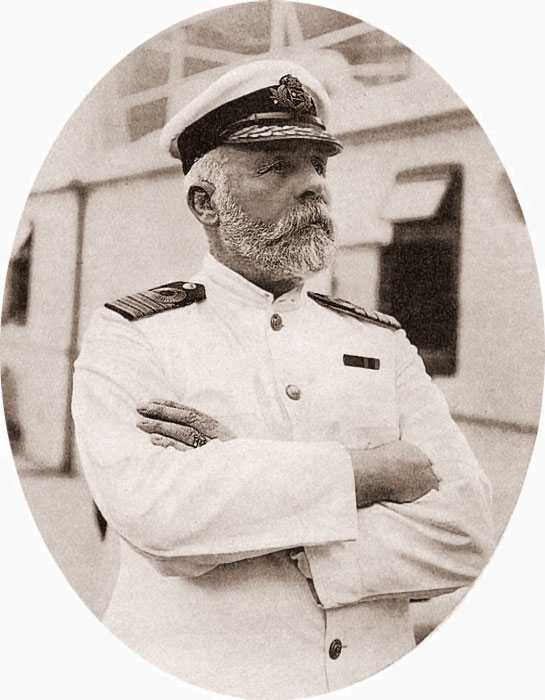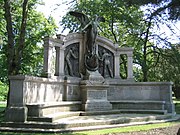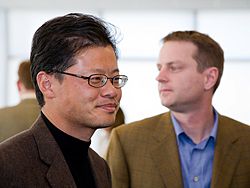
Barack Hussein Obama II (pronounced /bəˈrɑːk huːˈseɪn oʊˈbɑːmə/; born August 4, 1961) is the 44th and current President of the United States. He is the first African American to hold the office. Obama was the junior United States Senator from Illinois from January 2005 until November 2008, when he resigned after his election to the presidency.
Obama is a graduate of Columbia University and Harvard Law School, where he was the first African American president of the Harvard Law Review. He was a community organizer in Chicago before earning his law degree. He worked as a civil rights attorney in Chicago and also taught constitutional law at the University of Chicago Law School from 1992 to 2004.
Obama served three terms in the Illinois Senate from 1997 to 2004. Following an unsuccessful bid for a seat in the U.S. House of Representatives in 2000, Obama ran for United States Senate in 2004. His victory from a crowded field in the March 2004 Democratic primary raised his visibility, and his prime-time televised keynote address at the Democratic National Convention in July 2004 made him a rising star nationally in the Democratic Party. He was elected to the U.S. Senate in November 2004 by the largest margin in Illinois history.
He began his run for the presidency in February 2007. After a close campaign in the 2008 Democratic Party presidential primaries against Hillary Rodham Clinton, he won his party's nomination, becoming the first major party African American candidate for president. In the 2008 general election, he defeated Republican candidate John McCain and was inaugurated as president on January 20, 2009.
Barack Obama was born at the Kapi'olani Medical Center for Women & Children in Honolulu, Hawaii, United States,[6] to Stanley Ann Dunham,[7] an American of mainly English descent from Wichita, Kansas,[8][9][10] and Barack Obama, Sr., a Luo from Nyang’oma Kogelo, Nyanza Province, Kenya. Obama's parents met in 1960 in a Russian language class at the University of Hawaii at Mānoa, where his father was a foreign student on scholarship.[11][12] The couple married on February 2, 1961,[13] and Barack was born later that year. His parents separated when he was two years old, and they divorced in 1964.[12] Obama's father returned to Kenya and saw his son only once more before dying in an automobile accident in 1982.[14]
After her divorce, Dunham married Indonesian student Lolo Soetoro, who was attending college in Hawaii. When Suharto, a military leader in Soetoro's home country, came to power in 1967, all Indonesian students studying abroad were recalled, and the family moved to the island nation.[15] From ages six to ten, Obama attended local schools in Jakarta, including Besuki Public School and St. Francis of Assisi School.
In 1971, he returned to Honolulu to live with his maternal grandparents, Madelyn and Stanley Armour Dunham, and attended Punahou School, a private college preparatory school, from the fifth grade until his graduation from high school in 1979.[16]
Obama's mother returned to Hawaii in 1972 and remained there until 1977, when she relocated to Indonesia to work as an anthropological field worker. She finally returned to Hawaii in 1994 and lived there for one year before dying of ovarian cancer.[17]
Right-to-left: Barack Obama and half-sister Maya Soetoro, with their mother Ann Dunham and grandfather Stanley Dunham, in Hawaii (early 1970s)
Of his early childhood, Obama recalled, "That my father looked nothing like the people around me—that he was black as pitch, my mother white as milk—barely registered in my mind."[18] He described his struggles as a young adult to reconcile social perceptions of his multiracial heritage.[19] Reflecting later on his formative years in Honolulu, Obama wrote: "The opportunity that Hawaii offered—to experience a variety of cultures in a climate of mutual respect—became an integral part of my world view, and a basis for the values that I hold most dear."[20] Obama has also written and talked about using alcohol, marijuana and cocaine during his teenage years to "push questions of who I was out of my mind".[21] At the 2008 Civil Forum on the Presidency in 2008, Obama identified his high-school drug use as his "greatest moral failure".[22]
Following high school, he moved to Los Angeles in 1979 to attend Occidental College.[23] After two years he transferred in 1981 to Columbia University in New York City, where he majored in political science with a specialization in international relations[24] and graduated with a B.A. in 1983. He worked for a year at the Business International Corporation[25][26] and then at the New York Public Interest Research Group.[27][28]
After four years in New York City, Obama moved to Chicago, where he was hired as director of the Developing Communities Project (DCP), a church-based community organization originally comprising eight Catholic parishes in Greater Roseland (Roseland, West Pullman and Riverdale) on Chicago's far South Side. He worked there as a community organizer from June 1985 to May 1988.[27][29] During his three years as the DCP's director, its staff grew from one to thirteen and its annual budget grew from $70,000 to $400,000. He helped set up a job training program, a college preparatory tutoring program, and a tenants' rights organization in Altgeld Gardens.[30] Obama also worked as a consultant and instructor for the Gamaliel Foundation, a community organizing institute.[31] In mid-1988, he traveled for the first time to Europe for three weeks and then for five weeks in Kenya, where he met many of his paternal relatives for the first time.[32] He returned in August 2006 in a visit to his father's birthplace, a village near Kisumu in rural western Kenya.[33]
Obama entered Harvard Law School in late 1988. He was selected as an editor of the Harvard Law Review at the end of his first year,[34] and president of the journal in his second year.[35] During his summers, he returned to Chicago, where he worked as a summer associate at the law firms of Sidley & Austin in 1989 and Hopkins & Sutter in 1990.[36] After graduating with a Juris Doctor (J.D.) magna cum laude[37][38] from Harvard in 1991, he returned to Chicago.[34] Obama's election as the first black president of the Harvard Law Review gained national media attention[35] and led to a publishing contract and advance for a book about race relations,[39] though it evolved into a personal memoir. The manuscript was published in mid-1995 as Dreams from My Father.[39]
From April to October 1992, Obama directed Illinois's Project Vote, a voter registration drive with a staff of ten and 700 volunteers; it achieved its goal of registering 150,000 of 400,000 unregistered African Americans in the state, and led to Crain's Chicago Business naming Obama to its 1993 list of "40 under Forty" powers to be.[40][41]
For twelve years, Obama served as a professor of constitutional law at the University of Chicago Law School; as a Lecturer from 1992 to 1996, and as a Senior Lecturer from 1996 to 2004.[42] In 1993 he joined Davis, Miner, Barnhill & Galland, a twelve-attorney law firm specializing in civil rights litigation and neighborhood economic development, where he was an associate for three years from 1993 to 1996, then of counsel from 1996 to 2004, with his law license becoming inactive in 2002.[43]
Obama was a founding member of the board of directors of Public Allies in 1992, resigning before his wife, Michelle, became the founding executive director of Public Allies Chicago in early 1993.[27][44] He served from 1994 to 2002 on the board of directors of the Woods Fund of Chicago, which in 1985 had been the first foundation to fund the Developing Communities Project, and also from 1994 to 2002 on the board of directors of the Joyce Foundation.[27] Obama served on the board of directors of the Chicago Annenberg Challenge from 1995 to 2002, as founding president and chairman of the board of directors from 1995 to 1999.[27] He also served on the board of directors of the Chicago Lawyers' Committee for Civil Rights Under Law, the Center for Neighborhood Technology, and the Lugenia Burns Hope Center.[27]
Political career: 1996–2008
State legislator: 1997–2004
Main article: Illinois Senate career of Barack Obama
Obama was elected to the Illinois Senate in 1996, succeeding State Senator Alice Palmer as Senator from Illinois's 13th District, which at that time spanned Chicago South Side neighborhoods from Hyde Park-Kenwood south to South Shore and west to Chicago Lawn.[45] Once elected, Obama gained bipartisan support for legislation reforming ethics and health care laws.[46] He sponsored a law increasing tax credits for low-income workers, negotiated welfare reform, and promoted increased subsidies for childcare.[47] In 2001, as co-chairman of the bipartisan Joint Committee on Administrative Rules, Obama supported Republican Governor Ryan's payday loan regulations and predatory mortgage lending regulations aimed at averting home foreclosures.[48]
Obama was reelected to the Illinois Senate in 1998, defeating Republican Yesse Yehudah in the general election, and was reelected again in 2002.[49] In 2000, he lost a Democratic primary run for the U.S. House of Representatives to four-term incumbent Bobby Rush by a margin of two to one.[50][51]
In January 2003, Obama became chairman of the Illinois Senate's Health and Human Services Committee when Democrats, after a decade in the minority, regained a majority.[52] He sponsored and led unanimous, bipartisan passage of legislation to monitor racial profiling by requiring police to record the race of drivers they detained and legislation making Illinois the first state to mandate videotaping of homicide interrogations.[47][53] During his 2004 general election campaign for U.S. Senate, police representatives credited Obama for his active engagement with police organizations in enacting death penalty reforms.[54] Obama resigned from the Illinois Senate in November 2004 following his election to the U.S. Senate.[55]
2004 U.S. Senate campaign
See also: United States Senate election in Illinois, 2004
In May 2002, Obama commissioned a poll to assess his prospects in a 2004 U.S. Senate race; he created a campaign committee, began raising funds and lined up political media consultant David Axelrod by August 2002, and formally announced his candidacy in January 2003.[56] Decisions by Republican incumbent Peter Fitzgerald and his Democratic predecessor Carol Moseley Braun not to contest the race launched wide-open Democratic and Republican primary contests involving fifteen candidates.[57] Obama's candidacy was boosted by Axelrod's advertising campaign featuring images of the late Chicago Mayor Harold Washington and an endorsement by the daughter of the late Paul Simon, former U.S. Senator for Illinois.[58] In the March 2004 primary election, Obama won an unexpected landslide victory with 53% of the vote in a seven-candidate field, 29% ahead of his nearest Democratic rival, which overnight made him a rising star in the national Democratic Party and started speculation about a presidential future.[59][60]
In July 2004, Obama wrote and delivered the keynote address at the 2004 Democratic National Convention in Boston, Massachusetts.[61] He spoke about changing the U.S. government's economic and social priorities, while questioning the Bush administration's management of the Iraq War and speaking about obligations to American soldiers. He criticized heavily partisan views of the electorate and asked Americans to find unity, saying, "There is not a liberal America and a conservative America; there's the United States of America."[62] Though it was not televised by the three major broadcast news networks, a combined 9.1 million viewers saw Obama's speech, which was a highlight of the convention and elevated his status as a star in the Democratic Party.[63]
Obama's expected opponent in the general election, Republican primary winner Jack Ryan, withdrew from the race in June 2004.[64] Two months later, Alan Keyes accepted the Illinois Republican Party's nomination to replace Ryan.[65] A long-time resident of Maryland, Keyes established legal residency in Illinois with the nomination.[66] In the November 2004 general election, Obama received 70% of the vote to Keyes' 27%, the largest victory margin for a statewide race in Illinois history.[67][68]
U.S. Senator: 2005–2008
Main article: United States Senate career of Barack Obama
Obama was sworn in as a senator on January 4, 2005.[69] Obama was the fifth African American Senator in U.S. history and the third to have been popularly elected.[70] He was the only Senate member of the Congressional Black Caucus.[71] CQ Weekly, a nonpartisan publication, characterized him as a "loyal Democrat" based on analysis of all Senate votes in 2005–2007. The National Journal ranked him as the "most liberal" senator based on an assessment of selected votes during 2007; in 2005 he was ranked sixteenth most liberal, and in 2006 he was ranked tenth.[72][73] In 2008, Congress.org ranked him as the eleventh most powerful Senator,[74] and the politician who was the most popular in the Senate, enjoying 72% approval in Illinois.[75] Obama announced on November 13, 2008 that he would resign his senate seat on November 16, 2008, before the start of the lame-duck session, to focus on his transition period for the presidency.[76][77] This enabled him to avoid the conflict of dual roles as President-elect and Senator in the lame duck session of Congress, which no sitting member of Congress had faced since Warren Harding.[78]
Legislation
See also: List of bills sponsored by Barack Obama in the United States Senate
Senate bill sponsors Tom Coburn (R-OK) and Obama discussing the Coburn–Obama Transparency Act.[79]
Obama voted in favor of the Energy Policy Act of 2005 and cosponsored the Secure America and Orderly Immigration Act.[80] In September 2006, Obama supported a related bill, the Secure Fence Act.[81] Obama introduced two initiatives bearing his name: Lugar–Obama, which expanded the Nunn–Lugar cooperative threat reduction concept to conventional weapons,[82] and the Coburn–Obama Transparency Act, which authorized the establishment of USAspending.gov, a web search engine on federal spending.[83] On June 3, 2008, Senator Obama, along with Senators Thomas R. Carper, Tom Coburn, and John McCain, introduced follow-up legislation: Strengthening Transparency and Accountability in Federal Spending Act of 2008.[84]
Obama and U.S. Sen. Richard Lugar (R-IN) visit a Russian mobile launch missile dismantling facility in August 2005.[85]
Obama sponsored legislation that would have required nuclear plant owners to notify state and local authorities of radioactive leaks, but the bill failed to pass in the full Senate after being heavily modified in committee.[86] Obama is not hostile to tort reform and voted for the Class Action Fairness Act of 2005 and the FISA Amendments Act of 2008 which grants immunity from civil liability to telecommunications companies complicit with NSA warrantless wiretapping operations.[87]
In December 2006, President Bush signed into law the Democratic Republic of the Congo Relief, Security, and Democracy Promotion Act, marking the first federal legislation to be enacted with Obama as its primary sponsor.[88] In January 2007, Obama and Senator Feingold introduced a corporate jet provision to the Honest Leadership and Open Government Act, which was signed into law in September 2007.[89] Obama also introduced Deceptive Practices and Voter Intimidation Prevention Act, a bill to criminalize deceptive practices in federal elections[90] and the Iraq War De-Escalation Act of 2007,[91] neither of which has been signed into law.
Later in 2007, Obama sponsored an amendment to the Defense Authorization Act adding safeguards for personality disorder military discharges.[92] This amendment passed the full Senate in the spring of 2008.[93] He sponsored the Iran Sanctions Enabling Act supporting divestment of state pension funds from Iran's oil and gas industry, which has not passed committee, and co-sponsored legislation to reduce risks of nuclear terrorism.[94][95] Obama also sponsored a Senate amendment to the State Children's Health Insurance Program providing one year of job protection for family members caring for soldiers with combat-related injuries.[96]
Committees
Obama held assignments on the Senate Committees for Foreign Relations, Environment and Public Works and Veterans' Affairs through December 2006.[97] In January 2007, he left the Environment and Public Works committee and took additional assignments with Health, Education, Labor and Pensions and Homeland Security and Governmental Affairs.[98] He also became Chairman of the Senate's subcommittee on European Affairs.[99] As a member of the Senate Foreign Relations Committee, Obama made official trips to Eastern Europe, the Middle East, Central Asia and Africa. He met with Mahmoud Abbas before he became President of the Palestinian Authority, and gave a speech at the University of Nairobi condemning corruption in the Kenyan government.[100][101][102][103]
2008 presidential campaign
Main articles: United States presidential election, 2008, Barack Obama presidential primary campaign, 2008, and Barack Obama presidential campaign, 2008
Obama stands on stage with his wife and two daughters just before announcing his presidential candidacy in Springfield, Illinois, Feb. 10, 2007.
On February 10, 2007, Obama announced his candidacy for President of the United States in front of the Old State Capitol building in Springfield, Illinois.[104][105][106] The choice of the announcement site was symbolic because it was also where Abraham Lincoln delivered his historic "House Divided" speech in 1858.[106] Throughout the campaign, Obama emphasized the issues of rapidly ending the Iraq War, increasing energy independence and providing universal health care.[107]
Obama delivers his presidential election victory speech in Grant Park.
A large number of candidates entered the Democratic Party presidential primaries. The field narrowed to a duel between Obama and Senator Hillary Rodham Clinton after early contests, with the race remaining close throughout the primary process but with Obama gaining a steady lead in pledged delegates due to better long-range planning, superior fundraising, dominant organizing in caucus states, and better exploitation of delegate allocation rules.[108][109] On June 3, with all states counted, Obama was named the presumptive nominee[110][111] and delivered a victory speech in St. Paul, Minnesota. Clinton ended her campaign and endorsed him on June 7.[112]
Obama meets with 43rd President George W. Bush in the Oval Office on November 10, 2008.
Obama proceeded to focus on the general election campaign against Senator John McCain, the presumptive Republican nominee, in the lead up to the Democratic National Convention. He announced on August 23, 2008, that he had selected Delaware Senator Joe Biden as his vice presidential running mate.[113] At the convention, held August 25 to August 28 in Denver, Colorado, Hillary Clinton called for her delegates and supporters to endorse Obama, and she and Bill Clinton gave convention speeches in support of Obama.[114][115] Obama delivered his acceptance speech to over 75,000 supporters and presented his policy goals; the speech was viewed by over 38 million people worldwide.[116][117]
During both the primary process and the general election, Obama's campaign set numerous fundraising records, particularly in the quantity of small donations.[118][119][120] On June 19, 2008, Obama became the first major-party presidential candidate to turn down public financing in the general election since the system was created in 1976.[121]
After McCain was nominated as the Republican candidate, three presidential debates were held between the contenders spanning September and October 2008.[122][123] In November, Obama won the presidency with 52.9% of the popular vote to McCain's 45.7%,[124] and 365 electoral votes to 173,[125][126] to become the first African American president, as well as the first born in Hawaii.[127][128][129][130][131] In his victory speech, delivered before thousands of supporters in Chicago's Grant Park, Obama proclaimed that "change has come to America".[132]
The inauguration of Barack Obama as the forty-fourth President, and Joe Biden as Vice President, took place on January 20, 2009. In his first few days in office Obama issued executive orders and presidential memoranda reversing President Bush's ban on federal funding to foreign establishments that allow abortions (known as the Mexico City Policy and referred to by critics as the "Global Gag Rule"),[133] changed procedures to promote disclosure under the Freedom of Information Act,[134] directed the U.S. military to develop plans to withdraw troops from Iraq,[135] and reduced the secrecy given to presidential records.[136] He also issued orders closing Guantanamo Bay detention camp "as soon as practicable and no later than" January 2010.[137]
The first 100 days of Barack Obama's presidency included his signing into law a $787 billion economic stimulus package on February 17, 2009, aimed at helping the economy recover from the deepening recession. The bill included increased federal spending for health care, infrastructure, education, various tax breaks and incentives, and direct assistance to individuals.[138][139] Although Obama made a high-profile visit to Capitol Hill to engage with Congressional Republicans, the bill ultimately passed largely on a party-line vote.[140]
On February 18, 2009 he announced that the U.S. troop strength in Afghanistan would be boosted by 17,000. In the announcement, Obama asserted that the increase was necessary to stabilize a deteriorating situation in Afghanistan, which has not received the strategic attention, direction and resources it urgently requires. [141] On February 27, 2009, Obama declared that combat operations would end in Iraq within 18 months. Obama stated in his remarks to Marines who were about to deploy to Afghanistan, "Let me say this as plainly as I can: By August 31, 2010, our combat mission in Iraq will end."
In a 2006 interview, Obama highlighted the diversity of his extended family: "It's like a little mini-United Nations," he said. "I've got relatives who look like Bernie Mac, and I've got relatives who look like Margaret Thatcher."[173] Obama has seven half-siblings from his Kenyan father's family, six of them living, and a half-sister with whom he was raised, Maya Soetoro-Ng, the daughter of his mother and her Indonesian second husband.[174] Obama's mother was survived by her Kansas-born mother, Madelyn Dunham[175] until her death on November 2, 2008[176] just two days before his election to the Presidency. In Dreams from My Father, Obama ties his mother's family history to possible Native American ancestors and distant relatives of Jefferson Davis, president of the southern Confederacy during the American Civil War.[177] Obama's great-uncle served in the 89th Division that overran Ohrdruf,[178] the first Nazi camp liberated by U.S. troops during World War II.[179]
Obama was known as "Barry" in his youth, but asked to be addressed with his given name during his college years.[180] Besides his native English, Obama speaks Indonesian at the conversational level, which he learned during his four childhood years in Jakarta.[181][182] He plays basketball, a sport he participated in as a member of his high school's varsity team.[183]
Obama playing basketball with U.S. military at Camp Lemonier, Djibouti in 2006[184]
In June 1989, Obama met Michelle Robinson when he was employed as a summer associate at the Chicago law firm of Sidley Austin.[185] Assigned for three months as Obama's adviser at the firm, Robinson joined him at group social functions, but declined his initial requests to date.[186] They began dating later that summer, became engaged in 1991, and were married on October 3, 1992.[187] The couple's first daughter, Malia Ann, was born in 1998,[188] followed by a second daughter, Natasha ("Sasha"), in 2001.[189] The Obama daughters attended the private University of Chicago Laboratory Schools. When they moved to Washington, D.C., in January 2009, the girls started at the private Sidwell Friends School.[190]
Applying the proceeds of a book deal, the family moved in 2005 from a Hyde Park, Chicago condominium to a $1.6 million house in neighboring Kenwood, Chicago.[191] The purchase of an adjacent lot and sale of part of it to Obama by the wife of developer, campaign donor and friend Tony Rezko attracted media attention because of Rezko's subsequent indictment and conviction on political corruption charges that were unrelated to Obama.[192][193]
In December 2007, Money magazine estimated the Obama family's net worth at $1.3 million.[194] Their 2007 tax return showed a household income of $4.2 million—up from about $1 million in 2006 and $1.6 million in 2005—mostly from sales of his books.[195]
Obama is a Christian whose religious views have evolved in his adult life. In The Audacity of Hope, Obama writes that he "was not raised in a religious household". He describes his mother, raised by non-religious parents (whom Obama has specified elsewhere as "non-practicing Methodists and Baptists") to be detached from religion, yet "in many ways the most spiritually awakened person that I have ever known". He describes his father as "raised a Muslim", but a "confirmed atheist" by the time his parents met, and his stepfather as "a man who saw religion as not particularly useful". Obama explained how, through working with black churches as a community organizer while in his twenties, he came to understand "the power of the African-American religious tradition to spur social change".[196][197] He was baptized at the Trinity United Church of Christ in 1988 and was an active member there for two decades.[198][199] Obama resigned from Trinity during the Presidential campaign after controversial statements made by Rev. Jeremiah Wright became public.[200]
Obama has tried to quit smoking several times,[201] and said he will not smoke in the White House.
Read more...













